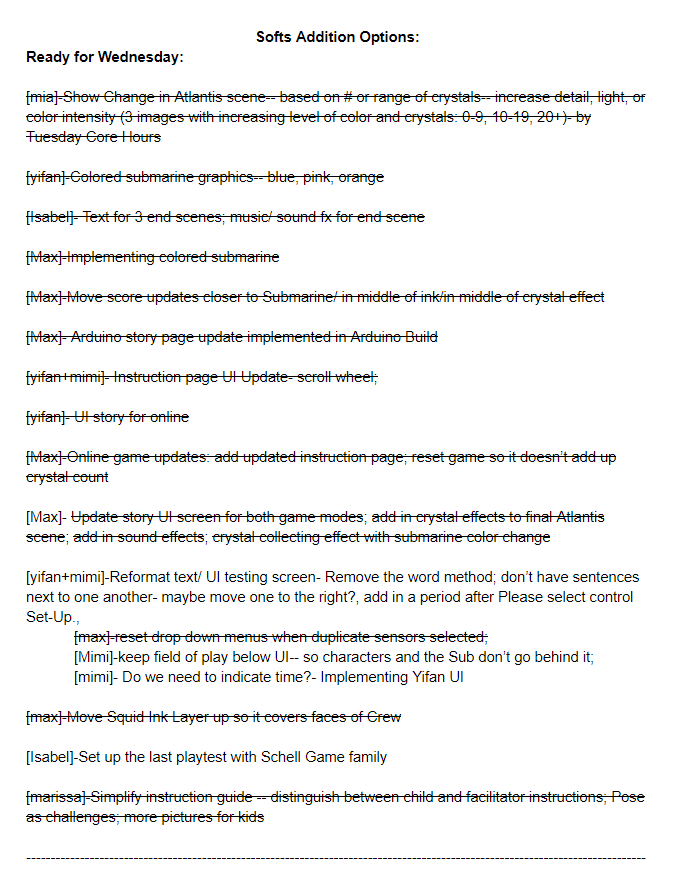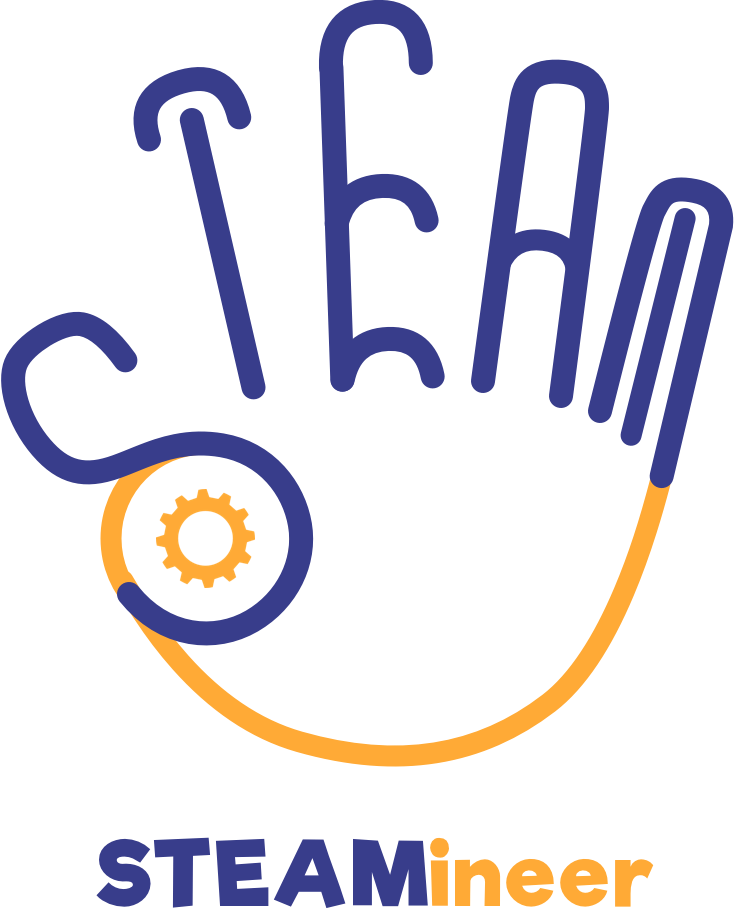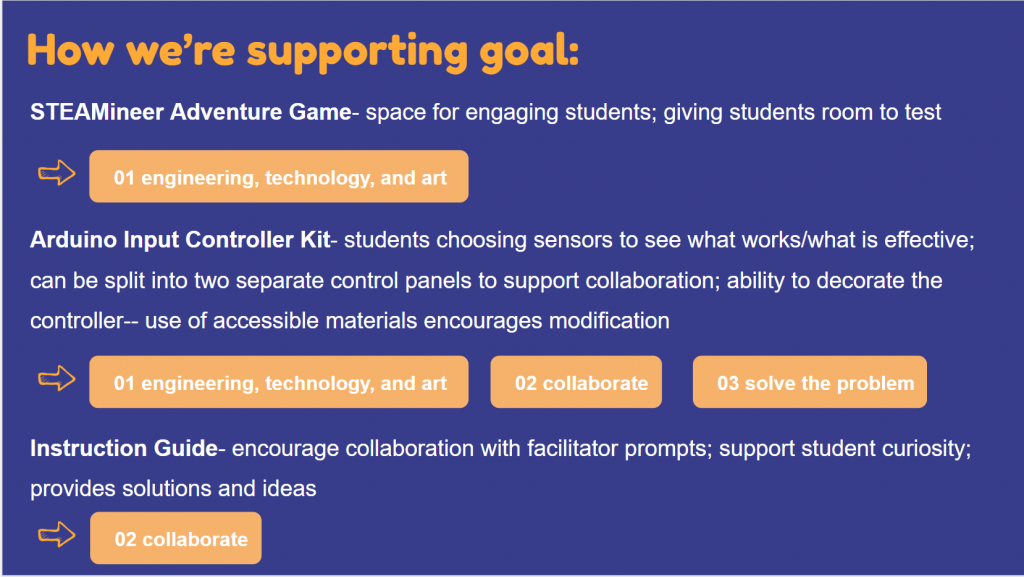Week 14 kicked off with Soft Opening (Softs). As a team we would normally see every member of the faculty for 15-20 minutes. During this time they would interact with our experience and give us feedback. This year, Soft opening was reformatted so that each team spent an hour video conferencing with select faculty. The sessions were recorded so that faculty who were not in attendance could review the presentation. Monday afternoon we met with Ruth, Melanie, and Shirley. David Purta and John Balash also attended the presentation, and David even hung around after to check-in and see the new effects Max added when players use different sensors. One benefit of remote soft opening was that we had the opportunity to meet Melanie and get her feedback. (Melanie is based at the ETC’s Silicon Valley campus and normally does not participate in the Pittsburgh Soft Opening.)
For our hour of Softs we prepared a presentation showcasing a live playthrough of the keyboard version of our game, video of playtesters experimenting and playing with the Arduino controller, and recorded video of the controller inputs being positioned in the controller. (The last video was one we recorded as a team since we do not yet have video of playtesters setting up the inputs on their own.) We also recorded video clips and a playthrough of the Arduino game with the new additions to the game based on our most recent playtest with Josh. Isabel and Marissa prepared the material for the presentation, Mia, Mimi, and Max all recorded videos, and Mia made the presentation look presentable. Prior to Softs, we shared a digital copy of the instruction guide and the online, keyboard version of our game with the faculty attending our session.
We started our presentation with Isabel describing the project goal and deliverables. During our presentation Max played through the keyboard version of the game (as players in our experience do at the start), we watched video from Josh’s playtest, and we briefly watched part of Mimi’s recording of the Arduino version of the game. Most of the time was spent discussing the project and sharing feedback. Feedback included concerns about the robustness of the controller and suggestions for accommodating different input devices, like other game controllers, so people could try out assigning their own functions at home with the resources available to them.
A fair chunk of the discussion was dedicated to iterations that needed to be made to the online game and the gameplay– particularly because that was the only element with which our faculty could engage. Our instructions online did not accommodate players who did not have a computer mouse accessible. Prior to Softs, both Shirley and Melanie ran into issues playing because they were dependent upon a touch-pad and not a mouse and therefore could not charge the submarine battery. If the battery has no juice in it, the game becomes a 2 minute timer that plays Carnival of the Animals and it can be rather frustrating. They also suggested that we have a more satisfying effect when players collect crystals. They were hugely in favor of the ink spray, but as it is a negative effect, felt we needed to do more to reinforce positive actions like collecting crystals. Speaking of positive feedback, they also suggested changing the game to reflect the number of crystals collected– either by changing the end scene or changing the scenery as the game goes. This way, players could have some sort of metric for success that could further encourage replayability and provide players with a payoff for their efforts.
We also got lots of specific feedback about how to address the wordiness in both our instruction guide and the testing space in the Arduino game. Both places had lots of extra words that were not necessary and were cluttering up the space. This clutter also made both spaces less user-friendly. Especially in the instruction guide, having too many words could make it inaccessible to younger players.
Lastly, they addressed how we needed to clarify what the future of our project is for the sake of our final presentation. Our project started in a discovery space and when we partnered with Assemble transitioned to deliverable. However, with the need for social distancing, we are no longer able to test with Assemble, and it is unknown whether or not Assemble will be able to host camps this summer. As a team we have had discussions with our advisers about presenting future possibilities for the project which is more aligned with discovery project deliverables. We had not yet determined the future of our project deliverables and it felt like the expectation from Softs was that our project would continue to be treated like a deliverable project despite the loss of our partner.
Following Softs, the team compiled all the specific takeaways that could be made to our experience in a Google doc. From there, we prioritized what to include for the next iteration of our game and who would be responsible for it. We left remaining items on another page in case there was time to implement it later or to include as future opportunities for the project in our final presentation. Then, we got to work.

Yifan and Mimi updated the UI for the testing space in the Arduino game so that it would be cleaner. They included a pop-up at the beginning to on-board players and remove the need for some of the text on the page. The drop-down menus were updated so that if a player tried to assign two functions with the same sensor, the most recent incident of the sensor selection would stay in place while the later incident of the sensor would reset. Marissa worked on reformatting the instruction guide to reduce the amount of text and replace some of the text with photos. It was also rearranged to have more kid-friendly slides at the beginning with more text-heavy informational slides in an Appendix for reference.
Yifan and Mia both worked on updating artwork for the game. Yifan created multi-colored versions of the submarine to support our new crystal collecting effect. When players collect crystals, the submarine color briefly changes to the color of the crystals collected. Mia created three different end scenes for the game with different levels of light and crystals to reflect player progress in the game. Players collecting 0-9 crystals, 10-19 crystals, and 20+ crystals have different end scenes. Isabel found victory music for the end scene and added in text to provide completion to the story. Max worked to implement all these updates in the game. Max also moved the pop-up +1 and -1 closer to the submarine so that players could see them more clearly. (Previously they were next to the crystal count in the top left hand corner. Max was also able to implement Yifan’s updates to the story in the Arduino game. Finally, Max implemented the applicable changes to the online, keyboard based game. We also made the submarine larger.
With Dave’s help, we were able to secure two families for playtesting over the weekend (One Saturday and One Sunday). With these playtests we hope to see if the updates to our experience provide for a more satisfying playthrough and if they promote more engagement with the controller. We also hope the experience runs more smoothly for playtesters with an updated instruction guide and a more standardized playtesting flow on the team’s end. We have also decided to make the experience two player and will get the opportunity to see how it operates as a two player experience this weekend. We have directed the playtesters to include two people in the activity and the controller is actually divided into two so different people can operate different functions. We are excited to see how it goes and get feedback from our playtesters!
We wrapped up the week meeting with our faculty to go over the future of our project. We discussed what our deliverables will be and how to best present the results of our work this semester. We have reached out to John Balash to see if we can “deliver” our instruction guide, evaluation materials, game, and Arduino controller to him for use at the ETC and with student groups. Mia talked about iterations that could be made to the controller including 3D printing it and/or laser cutting materials to make it. While both of these options would be more robust, timing does not allow us to playtest new materials. There is also consideration that has to be made about how materials could change the way players interact. Cardboard encourages modification and personalization– is that still something we want to include in our project? Right now decorating the controller has become a lower priority and our focus has been on getting players to rearrange inputs. (We are trying to address this in the next playtest by delivering the controller with the inputs out of place in hopes that players will position them.) Dave suggested including digital files for printing and cutting so that places like Assemble who have access to the technology can use the files to print or cut out their own casing. We are also planning to present how our work from the first half of the semester has informed our work during the second half of the semester and how our findings ultimately contribute to our initial goal.
Thank you for journeying with us this far! We have just a short while to go before we make landfall. Join us for the results of our final playtests and the end of our journey next week.














